Bill Loguidice's Blog, page 115
October 18, 2015
Review: 1byone Wireless Bluetooth Speaker Smart LED Night Light Bulb
There are lots of Bluetooth LED bulbs that change colors. There are lots of bulbs with Bluetooth speakers. However, not many combine both of those features in one product. The 1byone Bluetooth Smart LED Bulb is one such premium product that combines both of those compelling features and does so at a competitive price point (just $30.99 right now on Amazon, or you can also get it direct from the 1byone Website).

The packaging for the 1byone Wireless Bluetooth Speaker Smart LED Night Light Bulb.
It’s an attractive bulb with a sleek, modern design measuring 3.15 inches (8 centimeters) by 5.51 inches (14 centimeters) that should fit in most standard light sockets. The top portion features an LED bulb that can convert its seven main colors into over 16 million, including warm and cool white. The middle portion is the speaker.
You can wirelessly connect most Bluetooth-enabled smartphones, tablets, and computers directly to route all audio to the bulb. Google Android 2.3.3 and later, and Apple iOS 7.0 and later devices can use a free app to control LED color functionality.

The contents of the package.
What’s funny is that 1byone doesn’t tell you the app’s name in the manual or on the box. Fortunately, there was a QR code on the box, so I scanned that. Once scanned, the mystery app’s name was revealed to be CHSmartBulb. It automatically added another Bluetooth entry in addition to the earlier one I made on my wife’s Apple iPhone 6 Plus to test the speaker functionality.
On iOS, the app provided direct access to our iTunes library. The advantage the app has over just playing music from any app (in our case, our preferred Spotify) is that the colors will change automatically. There’s also manual or auto color changing options, the ability to turn the bulb on or off, as well as various timing functions. The app is no frills, but gets the job done.
Here’s a sampling of the audio quality:
Light intensity is fair. I’d judge the brightness better than that of a 40 watt bulb, but probably not quite as good as a 60 watt bulb. Speaker quality is excellent. Making the sound loud and room filling is no problem. The only area where the sound quality disappoints is in the bass response, but considering it’s a light bulb with such a small footprint, that’s a minor complaint. Overall, it’s a very cool product.
Thanks to 1byone for the review unit.
The post Review: 1byone Wireless Bluetooth Speaker Smart LED Night Light Bulb appeared first on Armchair Arcade.
October 16, 2015
Review: Keynice Universal Waterproof Case for Smartphones
We bring our smartphones with us everywhere these days, even places that we probably shouldn’t, like poolside or the beach. It’s for these latter places that something like the Keynice Universal Waterproof Case for Smartphones comes in so handy.

The packaging for the Keynice Universal Waterproof Case for Smartphones.
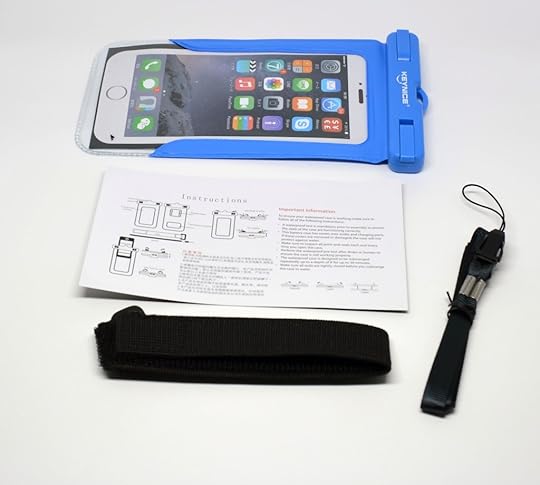
The contents of the package.
Available in three different colors – blue (reviewed), pink, and black – this waterproof plastic case protects your smartphone against the elements, including water. IPX8 certified for a waterproof depth of 67 feet (about 20 meters), more practically, the Keynice is designed for repeated water insertions of up to eight feet (about 2.4 meters) for 30 minutes.

One pair of snaps, with the other pair attached to the bag.

My Apple iPhone 6 Plus in Rokform case inserted in the sealed bag.
In addition to its two optional straps – a neck strap and an arm band – the Keynice has a simple five piece design. One piece is the plastic bag where you insert the phone, and the other pieces are two pairs of removable plastic snaps. You remove the two pairs of plastic snaps, insert the phone in the bag, then reassemble the two pairs of plastic snaps until you have a seal.

Running water over my phone.
While the Keynice is designed for smartphones up to 6 inches diagonal, it did struggle a bit with my Apple iPhone 6 Plus in its Rokform case. It fit, but was not easy to insert and remove. Smaller phones, or larger phones without bulky cases, should fit much better.

The neck strap attached.
In my testing, where I ran it under the sink and submerged it in a pot of water, there were zero leaks. Whether my smartphone, my wallet, or anything else that might fit in the bag, I’d feel confident it would be protected. In addition to being able to manipulate most of your smartphone’s functions when it’s inside the bag, the clear panels allow you to easily see the screen or whatever else happens to be inside.

The arm band attached.
Thanks to Keynice for the review unit.
The post Review: Keynice Universal Waterproof Case for Smartphones appeared first on Armchair Arcade.
October 15, 2015
Atari Flashback 6: The Official Game List
Since there’s been some confusion about the recently released AtGames Atari Flashback 6 (available at various big box retailers), thanks to a disparity between the box art and the games that are included, I thought it would be helpful to post the official list of titles that are actually present on the console.
Here’s the list:
3D Tic-Tac-Toe
Adventure
Adventure II
Air Raiders
Air·Sea Battle
Aquaventure
Armor Ambush
Asteroids
Astroblast
Atari Climber
Backgammon
Basketball
Black Jack
Bowling
Breakout
Canyon Bomber
Centipede
Championship Soccer
Chase It
Circus Atari
Combat
Combat Two
Crystal Castles
Dark Cavern (Night Stalker)
Demons to Diamonds
Desert Falcon
Dodge ‘Em
Double Dunk
Escape It
Fatal Run
Flag Capture
Football
Frog Pond
Frogs and Flies
Front Line
Fun with Numbers
Golf
Gravitar
Hangman
Haunted House
Home Run
Human Cannonball
Indy 500
International Soccer
Jungle Hunt
Maze Craze
Millipede
Miniature Golf
Miss It
Missile Command
MotoRodeo
Night Driver
Off-the-Wall
Outlaw
Polaris
Pong (Video Olympics)
Radar Lock
Realsports Baseball
Realsports Basketball
Realsports Soccer
Realsports Volleyball
Return to Haunted House
Saboteur
Save Mary
Sea Battle
Secret Quest
Shield Shifter
Sky Diver
Slot Machine
Slot Racers
Solaris
Space Attack
Space Invaders
Space War
Sprintmaster
Star Ship
Star Strike
Steeplechase
Stellar Track
Street Racer
Strip Off
Submarine Commander
Super Baseball
Super Breakout
Super Challenge Baseball
Super Challenge Football (NFL Football)
Super Football
Surround
Sword Fight
Swordquest: Earthworld
Swordquest: Fireworld
Swordquest: Waterworld
Tempest
Video Checkers
Video Chess
Video Pinball
Warlords
Wizard
Yars’ Return
Yars’ Revenge

AtGames Atari Flashback 6
The post Atari Flashback 6: The Official Game List appeared first on Armchair Arcade.
October 14, 2015
Technology Dinosaurs (Luddites) versus Technophiles
There was a thread on a forum I frequent (not referenced to protect both the innocent and guilty) with a topic of being a technological dinosaur. Basically it was individuals stating how they proudly eschew things like smartphones, digital music, digital cameras, Facebook, texting, etc., in favor of things like phones that only make calls, cassettes, LPs, film cameras, face-to-face interaction, etc.
Some said they did it for “nostalgia,” some that it was more “fun,” some that it was a case of “they don’t make it like they used to,” some that “life is too busy to mess around with new technology” (versus stuff they’re already comfortable with), etc. Many lamented modern technology as “dumbed down” or weren’t comfortable with the idea of data being in the cloud. The reasoning continued along those lines. Of course, several individuals also blamed things like texting for the dumbing down of society because of the heavy use of abbreviations and emoticons. I’ll address that one head-on a bit later.

SMBC. Source: http://smbc.myshopify.com/products/save-yourself-mammal-shirt-s
While I’ve written a bit about this before (here, for example), it’s still funny to me how some who are into some form of technology either never had or lost a love of new technology. I’m the opposite of a lot of the guys in that particular thread in that I’ve always been (and presumably always will be) a voracious technology consumer and try to own and use as much of the past and present technology as possible. I’d hate to not be experiencing all of the new stuff, even though the old stuff is still tons of fun and interesting in its own right.
As it Relates to Videogames
Another classic example, this time relating to videogames and conveniently brought up in that same thread, is the stereotypical/meme-like/overused notion that today’s controllers have too many buttons, making today’s games too difficult to play. While I agree there are a not insignificant portion of games out there that use every button on a modern controllers, in actuality, there are plenty of games that do a good job of limiting their controls to just the essentials.
I also agree that for games that make use of every controller button, unless you’re deeply committed to that one game for a while, it can be extremely difficult to remember everything when you go back to it. When I play games like that, I much prefer when they put context-sensitive prompts on the screen that pretty much tell you at all times what each button does (Diablo III on consoles is a good example of this). That’s a huge help.

The Xbox One Elite Controller
I wouldn’t want to go back to one, two, three, or four button controllers because it’s better to have options than not to (again, no one said every button needs to be used), but at the same time some designers/developers need to work on their interface design to make working with complex command setups easier. In short, it’s a software issue, not a hardware one. [Side note: I’m happy that the Xbox One will (soon) finally introduce universally mappable controls to consoles. That’s a long overdue step in the right direction that should further help the software guys bridge that gap.]
Some Perspective
While I realize that thread was meant as a sounding board for Luddites, I freely admit that from my perspective some of them sound like the people who lamented automation, horseless carriages, a TV in every home, etc. I think it may have been better in “their day” because that’s the time they last embraced what was new and exciting. Now, it sounds like they’re either unwilling or unable to embrace what’s new and exciting the same way they did in the past, so they steadfastly refuse to move on, or at least acknowledge some of the positives of the newest technology.
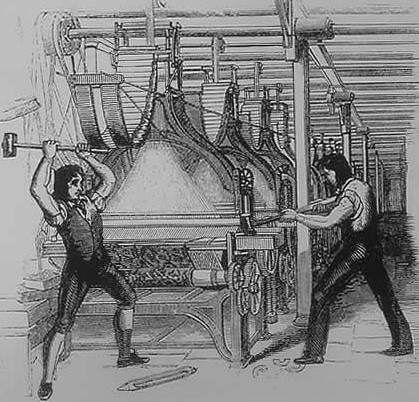
What I think of when some people lament today’s technology. Source: https://upload.wikimedia.org/wikipedia/commons/6/6e/FrameBreaking-1812.jpg
While some of them mention the negatives of modern technology and some of the positives of older technology, they seem to fail to do the reverse, and that’s mention the positives of modern technology and the negatives of older technology. It absolutely works both ways. People adopt new technology not just because it’s shiny and new, but also many times because it’s simply better in many ways than the old way of doing things.
I love vintage computers and consoles to an insane degree, but there are very few ways that I’d say they’re better than what we have now. Sure, some nice things were lost along the way in the name of progress, but much more has been gained that we frankly would have killed for back in the day.
Understanding Both Sides and a Bit about Texting
I think it’s OK to not like whatever tech or tech-related thing that’s out there, but at the same time I think it’s important for all of us to always make an effort to understand why others may like it in a non-denigrating manner (e.g., “they’re just stupid”). As much as some may dislike Facebook, it has a lot of positives. Just because something is radically different from what we’re used to shouldn’t cause some us to automatically recoil from it.
As for texting and how it’s making us more anti-social through, for one, less eye contact in the presence of others, I think that’s just society trying to get a grip on yet another (relatively) new form of communication. I suspect over time more social courtesies will develop around usage. As one example, I think wearables like the Apple or Android watches are one small step in getting us to stop looking at our phones so much and change the habit to more of a glance to see if something is really important. It’s certainly a known issue, and as with lots of other “manners” we take for granted, I’m sure more people over time will make efforts to do such things in a more socially responsible way.

That’s a killer phone she’s texting on. Source: http://media.ed.edmunds-media.com/non-make/ns/ns_41713_600.jpg
As for what we did before we had smartphones, again, being more connected than ever is something we just need to integrate better into our lives. There’s no reason to go backwards. Certainly in many ways it can easily be argued we’re more social than ever before (and anecdotally, that’s 100% true for me; I interact with far more people in more profound ways both personally and professionally than I ever would have before we had all this technology). Again, just because it’s a different form of communication than some of the more traditional methods, doesn’t make it bad. Far from it.
One reason texting is the way that it is – abbreviation and emoticon heavy – is that it’s not terribly efficient, even with swipe keyboards, to enter text on most mobile devices. That to me is merely an interface issue and one that I believe will be solved over time.
As for its effects on the dumbing down of writing, I’ve followed a simple philosophy for most of my life, i.e., I always try to write readable and properly punctuated sentences no matter the situation. I also instill that in my own daughters, as does my wife, who’s also a writer. They’re still young, so it doesn’t always sink in, but the point is we value that. I’m not sure society in general values that (and, despite our own personal causes, it’s ultimately up to society to determine what it does and does not value), which is why there’s such poor writing in general. As such, I don’t think texting is the cause of anything, just more of a systemic problem complicated to a degree by the awkwardness of our present texting interfaces.

Sure, if such a thing were possible, Shakespeare would be rolling over in his grave about our society’s poor writing skills, but the fact of the matter is the English he used is badly outdated and will continue to become increasingly difficult to get through as more generations come and go. Source: http://a3.files.biography.com/image/upload/c_fit,cs_srgb,dpr_1.0,h_1200,q_80,w_1200/MTE1ODA0OTcxNzgzMzkwNzMz.jpg
Let’s face it, language evolves, writing evolves. They’re going to continue to evolve. Technology is one facet of that evolution. I can tell you that I do 99% of my writing with a keyboard, which has caused my handwriting – which was never good in the first place – to further degenerate into a Doctor-like scrawl, except without the perk of a backing PhD. It’s literally painful for me to write more than a few sentences. Some would consider that a sad state of affairs, but instead I consider it adapting to the times and making efficient use of the tools available to me. Writing with a pen may as well be chiseling words into a stone tablet at this point to me.
The post Technology Dinosaurs (Luddites) versus Technophiles appeared first on Armchair Arcade.
October 13, 2015
Review: OxyLED E03S LED Solar Spotlight
 Solar powered outdoor lights are all the rage these days. Whether as decorative accent lights or as useful path highlighters, there’s a good chance you’ll see them throughout suburban neighborhoods. An interesting variation on these accent lights is the spotlight, which, instead of providing general area illumination, highlights a specific target, like a front door porch area. This not only can increase general attractiveness, but also help enhance security, particularly since you don’t have to remember to turn a light on or off.
Solar powered outdoor lights are all the rage these days. Whether as decorative accent lights or as useful path highlighters, there’s a good chance you’ll see them throughout suburban neighborhoods. An interesting variation on these accent lights is the spotlight, which, instead of providing general area illumination, highlights a specific target, like a front door porch area. This not only can increase general attractiveness, but also help enhance security, particularly since you don’t have to remember to turn a light on or off.

The box for the OxyLED E03S LED Solar Spotlight.
In regards to these types of spotlights, OxyLED offers the E03S LED Solar Spotlight, which I’m reviewing here. It’s solar powered, waterproof (IP44 rating) and heatproof, and can be secured in the ground with the included spike or wall mounted with the included hardware.

The contents of the box.
The spotlight itself has a single button for Low, Off, and High brightness. Low brightness lasts at least 9 hours, while high brightness (about 200 lumens) lasts at least 5 hours. In my testing, even the low brightness was suitably bright thanks to the four LEDs. With its built-in light sensor, it automatically goes on at night and automatically turns off and charges during the day.

Spiking the light into the ground.
The oversized solar panel adjusts 180 degrees, while the spotlight portion adjusts 90 degrees. The combination of the two should allow for optimal positioning regardless of where you place it.

It’s getting dark and the light is now on.
The built-in lithium rechargeable battery (3.7v, 2200Mah) should last at least one a half years before needing to be replaced. Replacement is as simple as opening the battery cover, removing the old battery, and then inserting the new battery.

The spotlight is fully adjustable.
For only $19.99 on Amazon right now, it’s a robust, elegant outdoor spotlight that can be used in a variety of ways. It’s another winner from OxyLED.
Thanks to Betterbox for the review unit.
The post Review: OxyLED E03S LED Solar Spotlight appeared first on Armchair Arcade.
October 12, 2015
Review: OxyLED 12 LED Pet UV Urine and Stain Detector Flashlight
 If you have pets, you have stains to clean up, plain and simple. Whether intentional or not, our pets can leave behind urine, vomit, or feces stains on our floors and furniture. Unfortunately, there’s no way to automatically see these types of stains–some are obvious, of course, but many dry up by the time we get there. That’s where something like the OxyLED 12 LED Pet UV Urine and Stain Detector Flashlight comes into play.
If you have pets, you have stains to clean up, plain and simple. Whether intentional or not, our pets can leave behind urine, vomit, or feces stains on our floors and furniture. Unfortunately, there’s no way to automatically see these types of stains–some are obvious, of course, but many dry up by the time we get there. That’s where something like the OxyLED 12 LED Pet UV Urine and Stain Detector Flashlight comes into play.

The box for the OxyLED 12 LED Pet UV Urine and Stain Detector Flashlight.
This ultraviolet (UV) light can not only be used to spot dried urine and other stains (like food) that animals (and their owners) can leave behind on floors, clothing, furniture, etc., but can also help you spot other undesirable objects like scorpions (*shudder*) and counterfit documents (money, driver’s licenses, passports, etc.) that don’t have the same UV-sensitive markings the legitimate versions do.

The contents of the box.
Operation is simple. Insert the three included AAA batteries and turn the flashlight on with its rubberized clicky button. While its 12 LED array is powerful enough to spot stains in brighter conditions, the best time to go stain hunting is when the room is darkened. The darker the room, the more noticeable the undesirable substance or object will fluoresce. As you can see from the photos, it had no trouble detecting some stains on our cat’s scratching platform.

The batteries go in a holder prior to insertion.

The UV light.
The OxyLED 12 LED Pet UV Urine and Stain Detector Flashlight is made from anodized aluminum and features an LED (395nm) bulb life of 50,000 hours, so it’s clearly built to last. With a 30 day money back guarantee, one year replacement warranty, and a low price of only $8.99 on Amazon for such impressive build quality, it’s an easy recommendation to make.

Yep, there’s some staining on our cat’s scratching platform.
Thanks to Betterbox for the review unit.
The post Review: OxyLED 12 LED Pet UV Urine and Stain Detector Flashlight appeared first on Armchair Arcade.
October 1, 2015
Magazine Hindsight (002) : Electronic Games, 06/1983
In this ongoing Armchair Arcade series, I take a look at random videogame- and computer-centric magazines from years past. I’ll point out particularly interesting content within each magazine and provide commentary from the perspective of what we know now. Whenever possible, I’ll provide direct links to PDF scans of the material so you can follow along.
Today’s feature, 002, is on the June 1983 issue of Electronic Games.
This is actually the very first videogame magazine I ever bought and a title that helped set me on the path that I continue on today. To say it was influential in my life would be an understatement. I still have a distinct memory of buying this very issue in the Foodtown supermarket near my childhood home. I flat-out devoured and memorized this issue, along with all of the others before the Great Videogame Crash claimed yet another victim in mid-1985.
In any case, in looking at the cover, it’s clear what attracted a boy who was into fantasy, among all the other geeky checkboxes this ticked off. Interestingly, I never did note the artist’s name, which is Ezra N. Tucker. He has a crappy Website today, but if you are able to click through it enough, you can see his artistic chops are as great as ever.
Also notable on the cover is the “closet classics” thing, a term I would come to use for quite a while, but would eventually abandon. It’s actually a great way to refer to what we refer to today as “cult classics.”
You’ll also note the blurb, “Expanded Computer Game Coverage.” Electronic Games would continue to provide excellent computer game coverage right through their grudging name change to Computer Entertainment, before the whole thing went poof.

Page 3 – Electronic Games, June 1983
Pages two and three have a M*A*S*H videogame ad. What’s interesting is that one of the second prizes is a TI-99/4a computer. Because it made use of the speech synthesizer, that computer probably had the best version of the M*A*S*H videogame. As we know, M*A*S*H II was never made, so who knows what became of the contest entries or the contest itself.
Page six has an Arnie Katz editorial that calls for game designer’s names to be prominently featured on the cartridges they design. As we’d see in the years that followed, that would happen in select cases, but never really became commonplace. There are only a select few designer’s whose names help to sell games, and that’s what obviously is the primary driver in letting the names share space with the Publisher/Development Company name.
Page seven has a Spectravideo SV-318 ad. It was one of the many budget computers to flood the market and then become absolutely irrelevant in the wake of Commodore’s dramatic C-64 price drops.

Page 10 – Electronic Games, June 1983
Page 10 shows a prototype of the ColecoVision’s Trackball controller (repeated on page 28; page 45 has a Coleco ad with yet another prototype variation). The four orange buttons were moved to a more logical location on the center console. Side note, Slither was an awesome pack-in.

Page 12 – Electronic Games, June 1983
Page 12 makes mention of Imagic supporting Intellivision. They’d go on to be one of the platform’s great third parties. Although flawed, the pictured Swords and Serpents was an innovative, simultaneous two player action dungeon crawl.
Page 14 makes mention of the Intellivision II and its accessories, as well as the Aquarius, which were all released. What was also mentioned, but sadly never released, was the Intellivision III (not to be confused with the INTV III). Both that and the Intellivision IV were casualties of Mattel getting out of the business. It’s a pity, because the planned hardware would have been incredible if they were able to pull it off.
Page 32 has an interesting feature about playing videogames over the telephone. That and other innovative ways of getting videogames, like over cable systems, did all see limited release over the years, but never became mainstream until the modern era.

Page 56 – Electronic Games, June 1983

Page 57 – Electronic Games, June 1983
Pages 56 and 57 show “screenshots” of two ColecoVision games, Sword and the Sorcerer, and Tunnels & Trolls, that never had much work done on them (much to my and many others’ dismay–I mean, they still look appealing today!), and obviously never got anywhere near release. Naturally, the screenshots, like many from back in the day were artist impressions of what the final product should look like. The Intellivision mockup for Advanced Dungeons & Dragons on page 56 also looked nothing like the finished product, although that was of course already released by this time.
Page 60 starts a review of the Intellivision version of Imagic’s classic Microsurgeon. What I find fascinating is that the mock-up screenshot on page 62 shows a textual vitals display instead of the impressive cross-body section. Side note, the TI-99/4a and IBM PCjr version of Microsurgeon are also well worth checking out, with the former featuring speech and the latter featuring even better visuals.
Page 76 starts a lengthy three page review for SSI’s hardcore war simulation, Germany 1985. Although rare, when Electronic Games deep dived on a game like this, I really ate it up.

Page 82 – Electronic Games, June 1983

Page 84 – Electronic Games, June 1983
Page 82 starts the Closet Classics feature. It’s interesting to note some of the lesser known (at the time) games mentioned have endured today with enthusiasts.
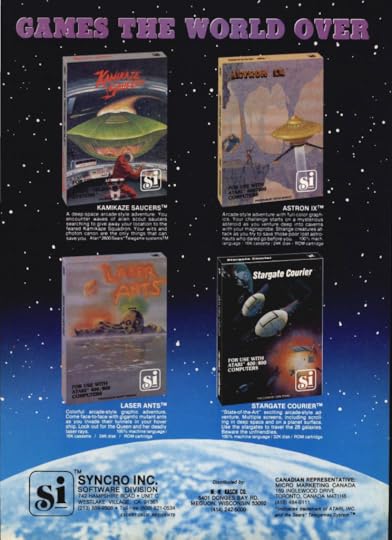
Page 85 – Electronic Games, June 1983
Page 85 has an uninspired ad for Syncro Inc.’s games. I have to admit I have little, if any, familiarity with these titles or the company itself, which I suppose is not that surprising considering how vague the ad is (noting that only Kamikaze Saucers mentions what platform it’s actually for).
The HES ad on page 87 for Gridrunner misspells the legendary Jeff Minter’s name as “Mintor.”
Page 92 has an arcade game review for Nintendo’s Popeye. It really was (and still is) a beautiful game.
Page 94 has a review for the Atari arcade release of Pole Position. It’s funny not to think of Pole Position as kind of always being around, so it’s nice to see this contemporary review.
Page 96 has a small ad for a video rental store. That was likely a good investment (approximately $82,500 in today’s dollars) for at least a few years before the big chains took over everything, and then they themselves were put out of business by video steaming.

Page 99 – Electronic Games, June 1983
Pages 98 – 101 are a review of the Votrax Type ‘N Talk. Notable is the Zenith Z-100 low profile computer on page 99, which was partially PC compatible, but also ran a version of CP/M. I have the model with the built-in monitor in my collection. I also have a Type ‘N Talk in my collection, although I’ve never been successful sending commands to it due to cable issues (I think I’m getting close, though).
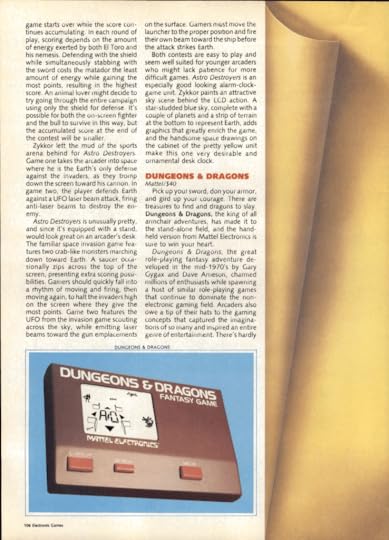
Page 106 – Electronic Games, June 1983
Page 106 shows Mattel’s excellent Dungeons & Dragons LCD game. I had that as a kid, although I’m sad to say it’s no longer in my possession.
Page 114 makes mention of the infamous Ultravision company in a reader Q&A. It was a promised super system compatible, at minimum, with Atari 2600 and ColecoVision games, that never came to be.
Page 188 makes mention of the potential release of an Atari 2600 adapter for the Atari 5200. That was a genuine desire at the time, particularly since Coleco and Mattel offered their own solutions for doing that very same thing on their respective consoles.

Inside Back Cover – Electronic Games, June 1983
The inside back cover has an ad for the Magnavox Odyssey2 port of the little-known arcade game, Turtles. That was notable because most of the Odyssey2’s titles were original creations. The port makes clever use of The Voice add-on, and is actually a pretty good game overall.
The post Magazine Hindsight (002) : Electronic Games, 06/1983 appeared first on Armchair Arcade.
September 30, 2015
Review: Aegend Running Waist Pack
While I’ve reviewed other excellent runner’s belts on Armchair Arcade, the Aegend Running Waist Pack is the first one I’ve received that’s been designed to specifically accommodate larger smartphones like my Apple iPhone 6 Plus. While most of those other runner’s belts could fit an oversized smartphone, it was definitely more of a struggle than it should have been. With the Aegend Running Waist Pack, while still not necessarily trivial, with its 6.2 in (15.7 cm) zipper opening, it’s certainly easier than the others I’ve tried to slide an oversized phone – even one in a decent-sized case like mine has – into its main pocket.

The box for the Aegend Running Waist Pack.

The contents of the box.
Besides the large main pocket, there’s also a front pocket for smaller items like keys, cash, or credit cards (or any combination thereof). There’s a clever headphone cable slot off the main pocket if for some reason you have yet to upgrade to Bluetooth headphones.
The strap itself is adjustable for waist sizes from 29 in (74 cm) – 41.7 in (106 cm), and features grey reflective stripes for enhanced safety when used at night. A moisture absorbing rear mesh panel lets you wear it all day, no matter the activity.

Before…

…After.
Perhaps most impressive is the low price, presently just $10.99 on Amazon. It’s well worth it if you need a convenient, hands-free carrier for your phone or other mobile device, regardless of activity.
Thanks to Aegend for the review unit.
The post Review: Aegend Running Waist Pack appeared first on Armchair Arcade.
Review: Easy@Home Areta Pulse Oximeter
 If you’ve ever been to the hospital or were at a particular type of doctor’s visit, you’ve probably been subjected to pulse oximetry. In this non-invasive method for monitoring oxygen saturation, a sensor is placed on a fingertip or earlobe (infants have to have it placed on their foot) that then passes two wavelengths of light through the body part to a photodetector. The changing absorbance at each of the wavelengths is then measured, allowing for an assessment of the adequacy of oxygen level in the blood.
If you’ve ever been to the hospital or were at a particular type of doctor’s visit, you’ve probably been subjected to pulse oximetry. In this non-invasive method for monitoring oxygen saturation, a sensor is placed on a fingertip or earlobe (infants have to have it placed on their foot) that then passes two wavelengths of light through the body part to a photodetector. The changing absorbance at each of the wavelengths is then measured, allowing for an assessment of the adequacy of oxygen level in the blood.
The Easy@Home Areta Pulse Oximeter is an FDA-approved fingertip device that provides an inexpensive and simple way for you to perform pulse oximetry at home. In fact, this device not only measures your blood oxygen saturation levels in a few seconds, but also your pulse rate.

The box for the Easy@Home Areta Pulse Oximeter.
In the package you get the pulse oximeter main unit, a carrying case, a neck/wrist cord to attach to the carrying case, two (2) AAA batteries to place in the main unit, and a detailed double-sided instruction sheet.

The contents of the box.
Although that instruction sheet is suitably thorough and includes a description of pulse oximetry, operating principles, and more, all you really have to do is place the sensor on your fingertip, press the power button, and look at your measurements. Once the pulse oximeter is on, you can press the power button again to switch between its four display modes. A long press enters the settings screen.

Assembly is complete.
Of special note is the Easy@Home Areta Pulse Oximeter‘s display, which is a high quality OLED type that’s easy to read. This is important because there’s a lot of useful information on the tiny screen, including a plethysmogram (wavy lines measuring changes in volume), battery indicator (looks like a cell phone battery indicator), pulse rate (smaller numbers in beats per minute, 25BPM – 250BPM range), functional oxygen saturation of arterial hemoglobin (large numbers as a percentage, 0 – 100%), and a bar graph. The bar graph corresponds to your pulse beat, with the height of the bar graph showing your pulse strength.

Taking a measurement.
If you’re at all interested in tracking this type of data or the Quantified Self in general, I can’t recommend the Easy@Home Areta Pulse Oximeter enough.
Thanks to Easy At Home Medical LLC for the review unit.
The post Review: Easy@Home Areta Pulse Oximeter appeared first on Armchair Arcade.
September 29, 2015
Review: 1byone Belt-Drive 3 Speed Stereo Portable Turntable
The present and future of music is digital. There’s no denying that. With that in mind, however, there’s a specific type of sound you can get from vinyl records that can’t really be reproduced digitally. It’s the type of sound that’s just a bit rough, just a tad imperfect, just a little flawed. In short, it’s what vinyl enthusiasts refer to as a “warm” sound versus the more “clinical” virtual perfection of digital (or at least the type of digital recorded at a high bit rate).

The box for the 1byone Belt-Drive 3 Speed Stereo Portable Turntable.
What do you do if you want to explore this retro musical format, but don’t want to spend hundreds of dollars or more to see what all of the fuss is about? The answer is you get something like the 1byone Belt-Drive 3 Speed Stereo Portable Turntable (company link, company product link). It’s reasonably priced, reasonably portable, and a more than reasonable way of diving into the resurgent world of music on vinyl.

The inside of the box.
The 1byone Belt-Drive 3 Speed Stereo Portable Turntable has a retro-inspired design, with a lightweight, suitcase-style wooden cabinet measuring approximately 13.4 in (34 cm) x 9.8 in (25 cm) x 4.5 in (11.5 cm). The cabinet is covered in a Poly Synthetic Leather (PU) that’s available in three different colors: turquoise, which is the one I’m reviewing, black, and denim. Those three color options for the PU material – and the PU material itself – are there for a reason, and that’s to bring to mind the type of style you’d see from 1960s-era technology. In that regard, 1byOne has succeeded admirably.
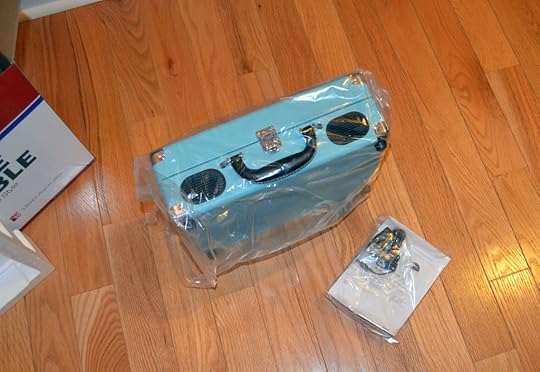
The contents of the box.
Although the concept and styling are decidedly retro, the technology the 1byone Belt-Drive 3 Speed Stereo Portable Turntable packs is not. Beyond the expected tone arm with soft damping control and selectable 33/45/78 RPM speed settings, there are two front facing speakers, side facing RCA and headphone jack outputs for connecting to speakers or headphones of your choice, and a side facing 3.5mm line-in port for connecting mobile or other devices.
Operation is just as you’d expect from a turntable. Plug in the AC adapter, turn on the turntable and set it to the appropriate sound level, select the RPM, place the record, open the tone arm clip to release the tone arm, push the lift lever backwards to raise the tone arm, then position the tone arm where you want on the record. Push the lift lever forward and the tone arm will place itself on the spinning record.

The ports are all on the side.
Although the turntable’s operation is straightforward, there are a few items to keep in mind. For one, when playing a 45 RPM record, you need to use the included adapter located in the holder near the tone arm. For another, there’s an auto stop on/off switch. If it’s not turned to ON, the record will not stop automatically when finished. Generally speaking, the only time you don’t want this set to ON is if for whatever reason a particular record stops prematurely.
The 1byone Belt-Drive 3 Speed Stereo Portable Turntable uses a ceramic stylus. This is good news, as universal ceramic cartridge stylus replacements are readily available from major retailers like Amazon, so you won’t have to worry when the needle inevitably wears down.

Playing a record.
So how does it play and sound? It played the modest selection of records in my collection without issue, save for one or two records skipping, which is sadly perfectly normal for those particular records, and records in general (particularly older ones). As you can tell from the video, the internal speakers sound reasonably loud, if lacking in bass. Naturally, decent external speakers or headphones sound much better.
The only major criticism I can levy against the 1byone Belt-Drive 3 Speed Stereo Portable Turntable is that for something meant to be transportable, there’s nowhere to store its AC adapter. Despite that oversight, if you’re interested in experimenting with vinyl or are already a vinyl enthusiast looking for a transportable record playing solution, I’d say it’s definitely worth taking a look at.
Thanks to 1byOne for the review unit.
The post Review: 1byone Belt-Drive 3 Speed Stereo Portable Turntable appeared first on Armchair Arcade.



